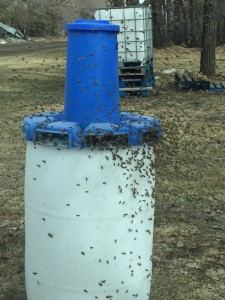Spring Bee Work

A Manitoba winter is unlike others in Canada. Our bees are confined to a wintering room for 5-6 months where they just sit and wait for spring. The only bee work required is sweeping dead bees every 10 days or so. Once the weather warms up, they need be be moved outside because the wintering room tends to get too warm.
We usually move bees out in March or April with the weather stays above -5 Celsius at nights.
As soon as the bees are moved outside, they get a mite treatment and 2 quarts of 1:1 sugar water. We also feed 2-3 pollen patties per hive depending on the strength of the hive. We also use a dry pollen feeder to supplement when there is no natural pollen around. As soon as the real thing is available, they abandon the substitute.
There are typically between 5 -10 percent deadouts (dead hives) coming out of winter. However, even hives that survive are in their most vulnerable state and are ‘not out of the woods’ yet. Mid-April night temperatures can easily plummet to -10 and that can be hard on small struggling hives. Many beekeepers place spring wraps on their hives, but we have never bothered.

The photo on top right shows a nice cluster on a cooler spring day when we first inspect them. This hive has the potential to make a nuc and generate 200 pounds of honey.
During the first warmer days, the bees take their first cleansing flights and the season is underway.
When the weather is warmer, usually in later April, we equalize hives. That means taking brood frames from strong hives and moving them to weaker ones. A typical response from an untrained eye would be to replace the queen, but that may not always be the case. We’ve had excellent results from boosting a hive with a frame or two of brood. These ‘brood bombs’ can make a huge difference and will get the queen laying again once her population is boosted.